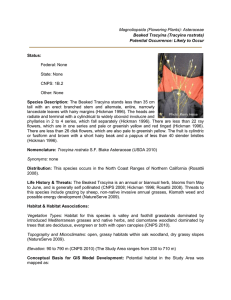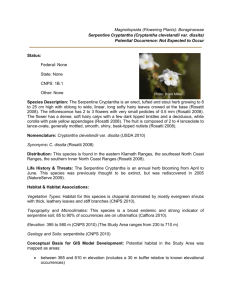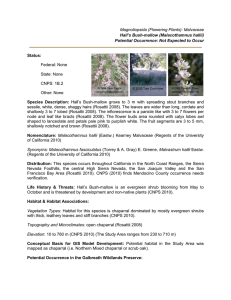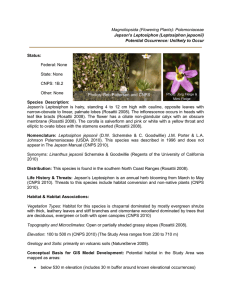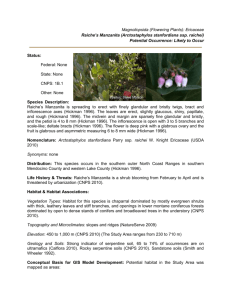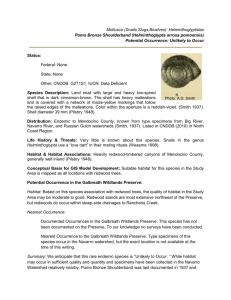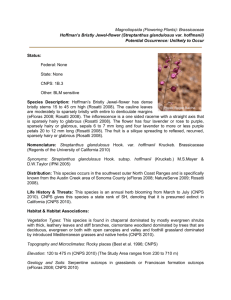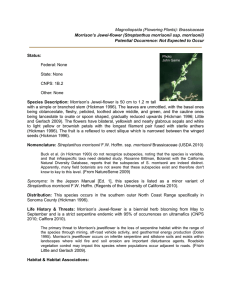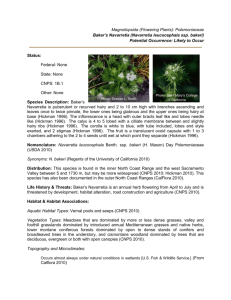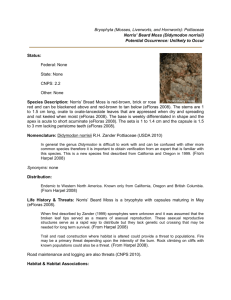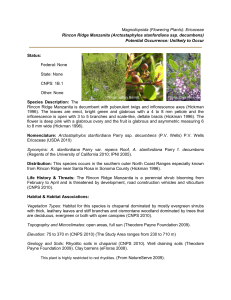ARCA Text
advertisement
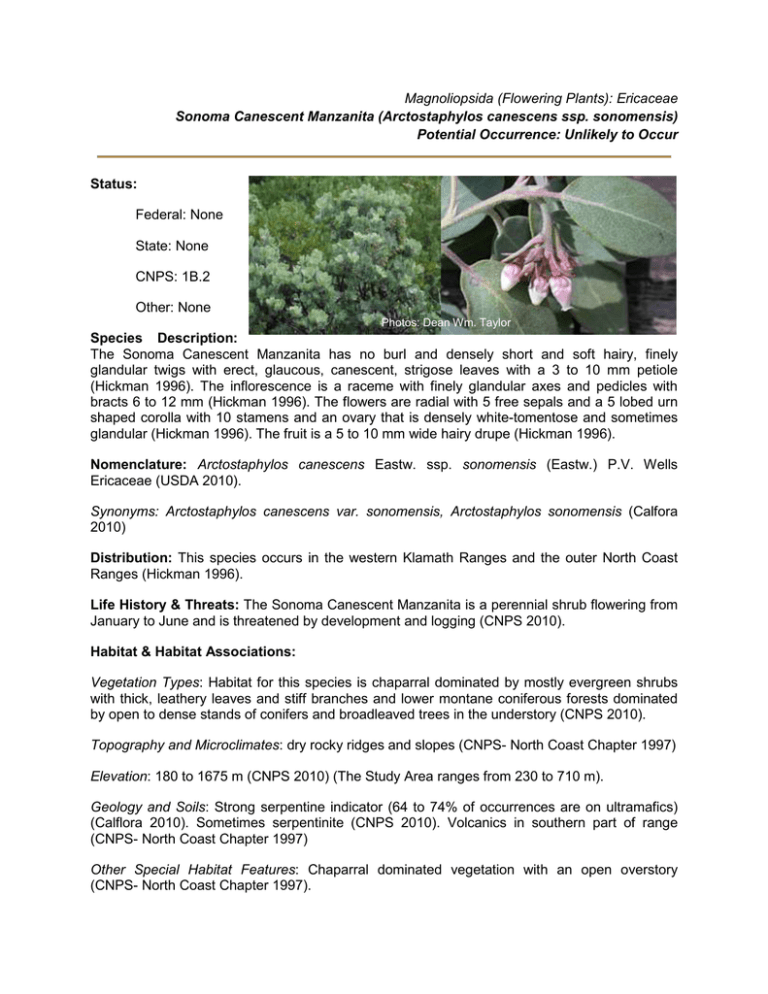
Magnoliopsida (Flowering Plants): Ericaceae Sonoma Canescent Manzanita (Arctostaphylos canescens ssp. sonomensis) Potential Occurrence: Unlikely to Occur Status: Federal: None State: None CNPS: 1B.2 Other: None Photos: Dean Wm. Taylor Species Description: The Sonoma Canescent Manzanita has no burl and densely short and soft hairy, finely glandular twigs with erect, glaucous, canescent, strigose leaves with a 3 to 10 mm petiole (Hickman 1996). The inflorescence is a raceme with finely glandular axes and pedicles with bracts 6 to 12 mm (Hickman 1996). The flowers are radial with 5 free sepals and a 5 lobed urn shaped corolla with 10 stamens and an ovary that is densely white-tomentose and sometimes glandular (Hickman 1996). The fruit is a 5 to 10 mm wide hairy drupe (Hickman 1996). Nomenclature: Arctostaphylos canescens Eastw. ssp. sonomensis (Eastw.) P.V. Wells Ericaceae (USDA 2010). Synonyms: Arctostaphylos canescens var. sonomensis, Arctostaphylos sonomensis (Calfora 2010) Distribution: This species occurs in the western Klamath Ranges and the outer North Coast Ranges (Hickman 1996). Life History & Threats: The Sonoma Canescent Manzanita is a perennial shrub flowering from January to June and is threatened by development and logging (CNPS 2010). Habitat & Habitat Associations: Vegetation Types: Habitat for this species is chaparral dominated by mostly evergreen shrubs with thick, leathery leaves and stiff branches and lower montane coniferous forests dominated by open to dense stands of conifers and broadleaved trees in the understory (CNPS 2010). Topography and Microclimates: dry rocky ridges and slopes (CNPS- North Coast Chapter 1997) Elevation: 180 to 1675 m (CNPS 2010) (The Study Area ranges from 230 to 710 m). Geology and Soils: Strong serpentine indicator (64 to 74% of occurrences are on ultramafics) (Calflora 2010). Sometimes serpentinite (CNPS 2010). Volcanics in southern part of range (CNPS- North Coast Chapter 1997) Other Special Habitat Features: Chaparral dominated vegetation with an open overstory (CNPS- North Coast Chapter 1997). Conceptual Basis for GIS Model Development: Potential habitat in the Study Area was mapped as areas in: chaparral (including scrub oak) coniferous forest (i.e. Redwood-Douglas fir mix (Sequoia sempervirens-Pseudotsuga menziesii) and Pacific Douglas fir (Pseudotsuga menziesii var.menziesii) vegetation types) with an understory of mixed or single-dominant hardwoods We additionally mapped the following attributes in the above areas as best potential habitat for this species as: rocky soils (i.e., very gravelly loam, gravelly loam, very cobbly loam, cobbly loam) on ridges (0 – 13 degrees) and south-facing slopes ((S, SE, or SW, > 7 degrees) GIS soils data indicates no volcanic or serpentine soils occur in the Study Area. Potential Occurrence in the Galbreath Wildlands Preserve: Habitat: The best potential habitat in the Preserve for Sonoma Canescent Manzanita is rocky soils on south-facing slopes and ridgelines in multi-story coniferous forest. Dry rocky slopes and ridgelines are very limited in distribution within coniferous forest. The largest patch of best habitat is in the northeastern corner of the Preserve. However, rocky outcrops are abundant throughout the Study Area in most vegetation types and may be under-represented in the GIS layer. Habitat quality is poor to moderate due to the lack of serpentine soils and chaparral. Sonoma Canescent Manzanita is highly associated with serpentine in the northern area of its range. To verify the lack of serpentine soils on the Preserve, we identified all areas (11 sites) of exposed rocky soils from high-resolution satellite imagery. During site visits to these areas, the only serpentine found were rocks exposed by road maintenance activity at a waterbar. In addition, chaparral, a common habitat type for this species does not occur within Preserve boundaries. Nearest Occurrence: Documented Occurrences in the Galbreath Wildlands Preserve: Previous species list for the Galbreath Wildlands Preserve did not document this species (SSU Field Station and Nature Preserves 2010). Nearest Occurrence to the Galbreath Wildlands Preserve: Sonoma Canescent Manzanita is known from 15 occurrences in Mendocino County and is also found in counties to the north (Humboldt), east (Lake) and south (Sonoma) of Mendocino (Calflora 2010). The majority of occurrences in Mendocino County are in USGS quads to the east of the Preserve (Calflora 2010) although two occurrences are documented in the northwest corner of the County. The nearest occurrence to the Preserve is approximately 13 miles to the northeast in the Upper Russian River watershed (Calflora 2010). Summary: We anticipate this species to be “Unlikely to Occur” because habitat quality is poor to moderate, habitat is limited in abundance, occurrence at the Preserve would constitute a western expansion of this species range in southern Mendocino County. References Calflora. 2010. Information on California plants for education, research and conservation.<http://www.calflora.org/>. Accessed 2010 Jul 8. California Native Plant Society (CNPS). 2010. Inventory of Rare and Endangered Plants. Online edition, v7-10b. <http://www.cnps.org/inventory>. Accessed 2010 Jul 8. California Native Plant Society (CNPS)- North Coast Chapter. 1997. Rare or Uncommon Plants of Northwest California; a regional supplement for CNPS Inventory of Rare and Endangered Plants. <http://www.northcoastcnps.org/cgi-bin/nc/sensnw.cgi/Home>. Accessed 2010 Jul 8. SSU Field Stations and Nature Preserves. 2010. Galbreath Wildlands Preserve Vascular Plant List. <http://www.sonoma.edu/preserves/docs/galbreath_vascular_plants.pdf>. Accessed 2010 Jun. Taylor DW. 2006. Arctostaphylos canescens ssp. sonomensis. <http://calphotos.berkeley.edu/cgi/img_query?enlarge=0000+0000+0907+0646>. Accessed 2010 Nov 8. United States Department of Agriculture (USDA). 2010. PLANTS Profile. <http://plants.usda.gov/java/nameSearch?mode=symbol&keywordquery=ARCAS3>. Accessed 2010 Nov 8. Species Account Description: Linden Schneider
